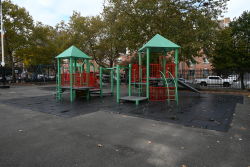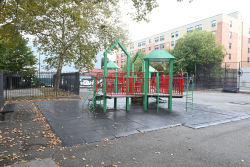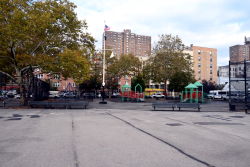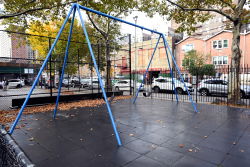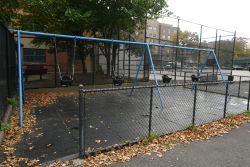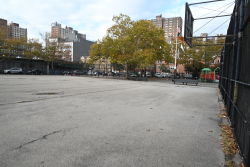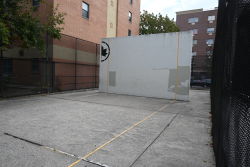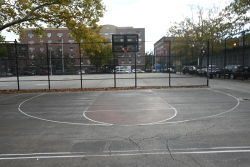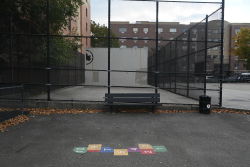Pontiac Playground
Pontiac Playground
Pontiac Playground is located north of P.S. 5 and east of Pontiac Place in the Port Morris neighborhood of the Bronx. Since the late 17th century, this area was part of Morrisania, the vast estate owned by the Morris family. During the 18th century, their holdings grew to a total of 1,920 acres--or most of the southwestern corner of the modern day Bronx. The family established a seaport on the East River, and the surrounding neighborhood became known as Port Morris. By the middle of the 19th century, most of the Morris estate had been divided into smaller parcels. The rugged, rocky hills of upland Port Morris made a dramatic setting for elegant private homes and for St. Mary’s Park, one of the six original parks acquired for the Bronx in 1888.
Pontiac Place was excavated from solid rock to reach the hilltop mansions. A descendant of a local family claimed that this one-block-long street was named for a Bronx political club of the 1880s. While it is possible a related group was active at that time, the well-known Pontiac Democratic Club was not formed until 1921. It was named for Chief Pontiac of the Ottawa tribe, just as the New York City political club Tammany Hall (originally the Society of St. Tammany) had been named for Tamanend, a legendary chief of the Delawares. When the Bronx club was registered, the name was misspelled as “Pondiac,” and the name stuck until the group disbanded in 1972.
Pontiac (c. 1720-1769) was widely regarded as a master strategist and a symbol of Native American resistance. Born in northwest Ohio, he became a chief of the Ottawas by 1755. Although many of the tribes in the Great Lakes region were on friendly terms with French settlers, the influx of British traders posed a new threat to Native American ways of life. In 1762 Pontiac challenged local tribes to unite and to drive the British from the area. Between 1763 and 1766, the confederacy of Ottawas, Hurons, Potawatomis, Miamis, Delawares, Senecas, Shawnees, Kickapoos, Chippewas, and others attacked twelve British forts and captured eight of them. After the protracted siege of Detroit, Pontiac’s Rebellion ultimately ended in defeat. He signed a treaty of peace and amity with the British in 1766. Pontiac was murdered by a Peoria Indian in Cahokia, Illinois in 1769.
In 1959 the City of New York acquired land for a new school and playground in Port Morris. Construction of P.S. 5, also known as the Port Morris School, was completed in 1961. The playground opened the following year under the joint auspices of Parks and the Department of Education.
In 1997-98, a reconstruction of the playground, providing new play equipment, safety surfacing, basketball ball court surface, asphalt pavement, fences, and benches, was completed with city funds allocated by the mayor.
Check out your park's Vital Signs
Clean & Safe
Green & Resilient
Empowered & Engaged Users
Share your feedback or learn more about how this park is part of a
Vital Park System

